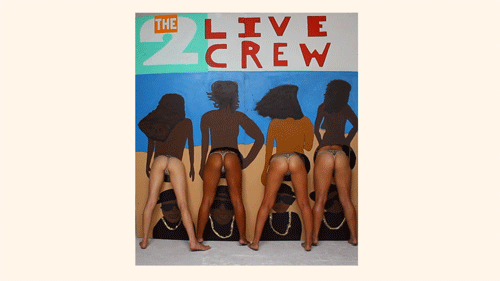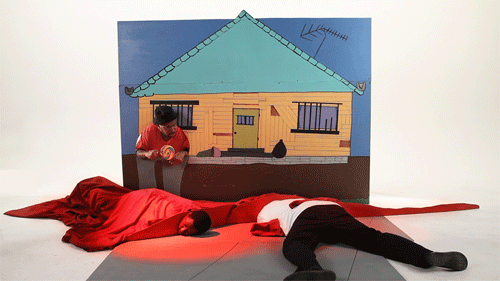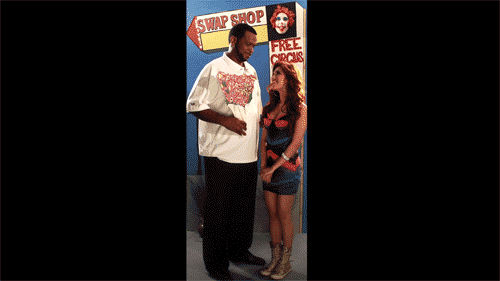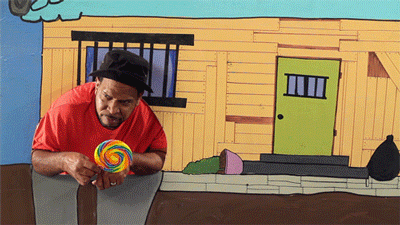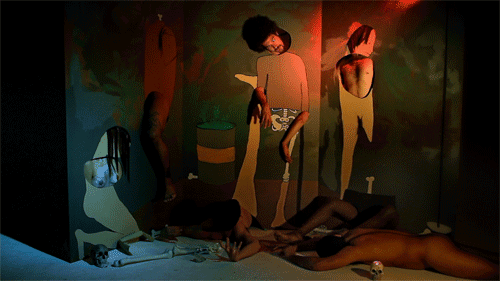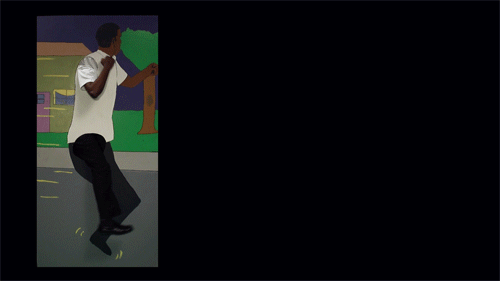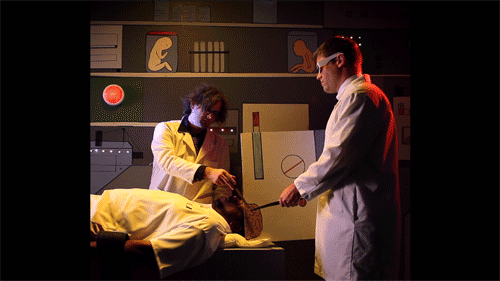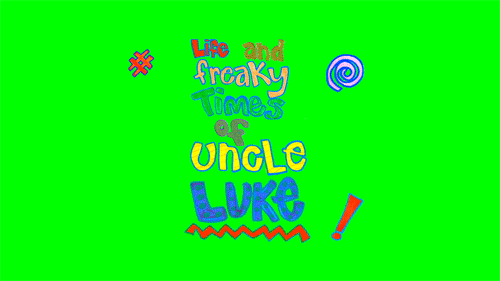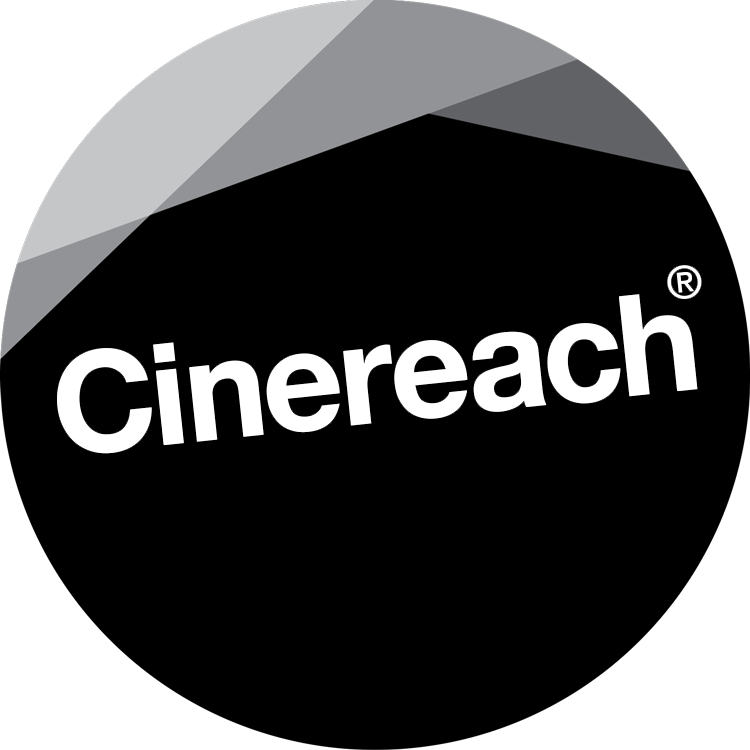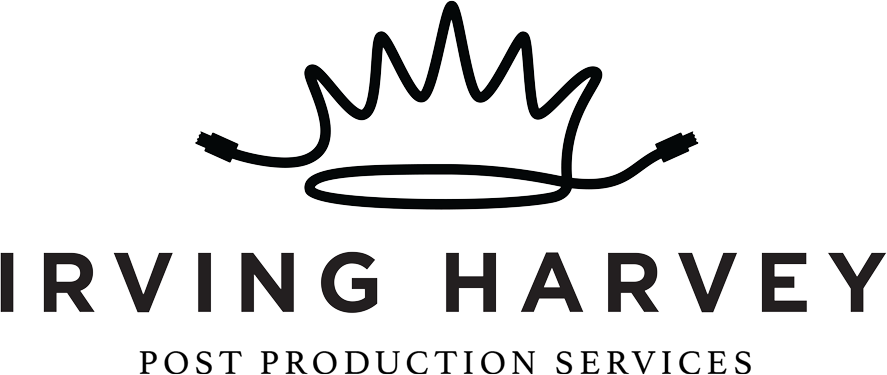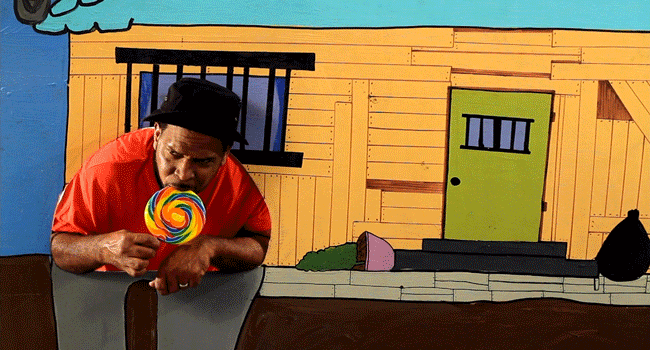
Life and Freaky Times of Uncle Luke
2012
Lucas Leyva & Jillian Mayer
A modern Miami adaptation of the 1962 French short film 'La Jetee', the film recounts Luke's (Uncle Luke, legendary rapper from the hip-hop group 2 Live Crew) rise to fame as he changes the face of hip-hop and fights for first amendment rights- and later as he ushers Miami into a golden era of peace and prosperity as Mayor. Everything changes when the Turkey Point Nuclear Reactor has a meltdown and turns Miami into a post-apocayptic wasteland.
Mayer\Leyva created this film for Borscht 7
PRESS
"[One of] twenty-five must-see shorts from over a century of cinema…. [The Life & Freaky Times of Uncle Luke is] smart, weird fun…. Filmmakers Jillian Mayer and Lucas Leyva borrowed a great story and made it completely their own." Fandor
"10 Shorts You Must See at Sundance This Year" Indiewire
“5 Out of 5 Stars”Film Threat
“One of the most fun and fresh films at Sundance”Movieline
"We all love ‘La Jetee,’ the French science-fiction film from the 60s about time travel in a post-nuclear war Paris… but wouldn’t we love it more if it were set in Miami and starred Luke Campbell from 2 Live Crew? The answer is yes, we would love it more in that circumstance." MTV
"The Life & Freaky Times of Uncle Luke… is one of the most fun and fresh (to def, even) films I saw [at Sundance]" Movieline
”Mind-blowing”Filmmaker Magazine
”Dropping Uncle Luke’s odd, obnoxious personality into this artsy milieu actually feels somehow true to rap’s subversive, smart-dumb spirit… Freaky Times, out of the box and Sundance-approved, forms a boldly instructive example of how to redress the misrepresentations that have traditionally marred the genre’s mainstream record.“ Spin Magazine
GIFS
essay
Child of Technology: Jillian Mayer’s Multimedia Identity Games
by Annie Hollingsworth (Originally published as the cover story in the September/October 2011 issue of Art Papers Magazine.)
Jillian Mayer, a young artist born and raised in Miami, tells the story of a recent trip to Buenos Aires. She was displaying her collection of Simpsons finger puppets—crudely-knit interpretations of the characters sold around the world—which her Argentinian friend recognized immediately: “Oh, I love Los Simpsons, I grew up with them, they’re a part of my family!” Mayer says the same thing. In a nature-culture substitution, she claims to have grown up in the company of an animated family. She also credits Full House, Family Matters, and Beverly Hills 90210 with major life lessons. The identities of many young people were formed around the two-dimensional ethics and fictional family dynamics delivered nightly during prime time. Often, television characters were more influential than real-life role models. It was a different era, before the Internet, when characters and plot turns were a collective point of reference. Kids who weren’t allowed to watch TV were, for better or worse, disconnected from the mainstream. Since then, technological revolutions have drastically altered the relationship between individuals and the media they consume. Yet, sitcom logic continues to surface as once-voracious TV fans become cultural producers themselves. As an artist, Mayer is both a fan and a critic of television, indebted to the golden age of the sitcom and charting ahead into the still open-ended structure of the Internet.
Recently, Mayer has made a sudden and unconventional entrance into the international art world and the public eye—appropriately, on YouTube. In the summer of 2010, the Guggenheim Museum sent out an international call to video artists for YouTube Play, a curatorial experiment designed to uncover new talent and explore the power of the Internet as a creative arena. The selection committee received over twenty-three thousand video submissions from ninety-one countries, which were uploaded to YouTube. Twenty-five works were ultimately selected, including Mayer’s Scenic Jogging, 2010, which was subsequently shown at Guggenheim outposts in New York, Venice, Bilbao, and Berlin as well as on a YouTube channel set up by the museum.
Six months later, Mayer was commissioned by the Miami-based Borscht Film Festival to produce three short videos. One of them, I Am Your Grandma, 2011, was posted on YouTube following the blockbuster festival screening. As Mayer and her collaborators predicted, the video went viral immediately, with over 220,000 hits in the first week. I Am Your Grandma was designed for mass appeal. Humor, short-attention-span pacing, and an addictive soundtrack by Miami-based band ANR -now available on iTunes - make it as engaging as a Super Bowl commercial break. A title screen introduces the video’s content: “Video Diary Log: A Message to my Future Unborn Grandchild.” Mayer posits video as a medium of lasting intergenerational communication, a way to accurately send the present into the future. She plays herself—the author—dressed in elaborate feature-distorting costumes inspired by legendary performance artist Leigh Bowery. I Am Your Grandma leans towards the fictional. On the internet, its intention and authenticity are totally undefined.
To date, I Am Your Grandma has gotten almost a million hits. It has been spoofed—mostly by kids. It has spawned micro-communities on Facebook and YouTube. Its title has entered the online Urban Dictionary as a slang term for “when something is really weird and terrifying and traumatizing in a way you can’t forget.” Online comments highlight the majority disposition of the Internet community—many honed in on buried sexual undertones and Mayer’s shocking costumes in sometimes crude and raw language. A few proposed marriage.
Regardless of its unconventional exhibition history, I Am Your Grandma was originally produced for the art world, a context that does elicit more sophisticated viewer responses. A month before its Borscht Film Festival’s screening, I Am Your Grandma was included in Family Matters, Mayer’s first solo show [David Castillo Gallery, Miami; April 9—May 7, 2011]. Titled after the television show, Family Matters teased out a slightly different interpretation of I Am Your Grandma: the definition of individual identities within the family structure. Here, family roles become fictional constructions shaped by stereotypical expectations.
The details of Mayer’s technology-driven debut are in perfect step with her conceptual territory. She plays games with popular media, the public, and the art world. Reception is central to the work: its fate and the layers of interpretation it accrues as it crosses channels and institutions are often as relevant as its message. Technology plays a deliberate, crucial, and multidimensional role in terms of production and as a means of intersection with public and private memory. Some of her visual references tap into specific cultural histories. Others are offered to a mass of anonymous viewers with an invitation for unqualified public response. In the context of the art world—Mayer’s primary audience—viewers become subjects in her nostalgic experiments as well as witnesses to sociological phenomena happening elsewhere.
In Mayer’s practice, popular culture stands in for nature—it is our artificial garden. Her work puts forth a powerful assumption: following our birth into a biological world, we develop in an environment of manufactured cultural products. As Scenic Jogging succinctly demonstrates, gaps erupt when we fail to simulate nature’s full complexity. Here, Mayer runs through a deserted urban neighborhood, attempting to keep up with projected nature scenes that move quickly across warehouse walls. The video’s rapid pacing produces an acute sense of anxiety. Her character is perpetually unable to catch the landscape where, metaphorically, she could find rest. The nature images—idealized and simplified landscapes designed as default screensavers&mdashare incomplete representations: insufficient and impenetrable. Scenic Jogging points towards a cultural dilemma: we may never be able to locate ourselves fully within a manmade world. Inevitably, uneasiness pervades.
In nearly every project, Mayer considers the implications of early identity formation within a manufactured reality. Her installations and video projects frequently include what she calls “boards"—two-dimensional painted scenes with cutout spaces for performers’ bodies. The boards take us back to a world of children’s entertainment clearly influenced by Saturday Morning TV, amusement-park photobooths, and the exaggerated world of Pee-wee’s Playhouse. They also reference—albeit less directly - the faux-domestic interiors of sitcom world, theatrical sets where family dramas take place. Mayer’s boards also generate funny and distorted images of bodies—like the costumes in I Am Your Grandma.
In Family Matters, childhood and family scenarios were reenacted through the boards—but something was always wrong. Characters were sited in cartoon-accident scenes, around a broken chandelier or under a fallen tree. Performers occupied the sets during the opening reception, their bodies extending out at odd angles. Their facial expressions were bored and nonchalant. Then, for the run of the show, the boards were left empty—a variation that allowed viewers to mentally insert themselves into the scenes. In both cases, Mayer externalized a Freudian creepy space, the dark side of family dynamics. A hint of morbid childhood imagination mixed in with repression of physical violence and emotional trauma. Memory is the place where fantasy and reality become indistinguishable, a blurring made even more dramatic when measured against television morality.
Family Matters adeptly blends aesthetic styles from a specific media moment—1980s and 1990s television. As such, viewers of Mayer’s generation are more likely to react viscerally to her board-based work. For this demographic, she plugs directly into the mainline of an earlier and more impressionable age, potentially surfacing all kinds of latent memory material. In other words, her viewers’ responses are bound to be age-specific. On one axis is the path of identity development from early childhood, through adolescence and into adulthood. On the intersecting axis are rapidly evolving technology and popular media. Each viewer’s specific intersection along these axes will determine which psychological stage her work activates. Postmodern cultural theory bemoans this specificity as the fracturing of a unified public.
We As Me, 2010, a video featured in Family Matters, makes a light-hearted statement on the technological dimension of identity formation. Here, Mayer is less a critic than she is a fan. We As Me presents a pair of slightly disoriented characters: a red girl and a blue girl. They are divided aspects of an electronic self that can be reunited, in theory, by putting on a pair of old-school 3D glasses. It’s just a joke, though. With or without the glasses Mayer provided for the exhibition, the two characters eventually find their way into a single image. They merge into a fictional Technicolor version of the artist, who plays herself. Here, again, "Jillian Mayer” is a constructed character, illustrating the fact that identity is fluid, culturally induced, and temporally specific.
Mayer’s own childhood relationship to television characters clearly informs her work. She recalls: They were real to me… that’s how the youngest child is supposed to act. That’s the relationship between the teenage girl character and the mother. They fight. You know. So then I thought, okay the cool character does do that in school, the girl that looks like the nerd is the nerd… I followed a lot of the cues they would give me on TV, I watched a lot of it and I would make jokes that it raised me. With reality shows now dominating the mainstream television market, the line between fiction and reality is even blurrier.
The short standalone film Life and Freaky Times of Uncle Luke, 2011, made in collaboration with Rakontur Films and screenwriter Lucas Leyva, crystallizes the thematic and structural layers of Mayer’s work. It also uses her boards as both stage and backdrop. Originally screened at the Borscht Film Festival and later shown in the group exhibition Sum of the Parts [David Castillo Gallery; May 14—June 25, 2011], Life and Freaky Times of Uncle Luke is a take on Chris Marker’s cult 1962 film La Jetée. Pop culture phenomenon Luther Campbell—aka Luke Skyywalker or Uncle Luke—is cast in the central role. In real life, Campbell is a Miami celebrity, former member of 2 Live Crew—the controversial group famous for sexually explicit tracks like Me So Horny—and future Miami mayoral candidate. Like the Terminator who became Governor of California and former Minnesota Governor/WWF wrestler Jesse Ventura, Campbell bizarrely blends personality with pop culture persona. Following the storyline of La Jetée, Campbell plays a slightly altered version of himself as a time-traveler who revisits his memories.
Uncle Luke begins in Miami’s Liberty City, where the Luther Campbell character sees a man get killed. “Damn! Motherfucker just got cut! To the white meat!” The story then merges into actual events from Campbell’s life. He rises to fame and is subsequently brought to trial for obscenity—in Leyva’s script, the court case is “Stale White Bitches vs. The 2 Live Crew.” Uncle Luke then fast-forwards through an imagined sci-fi future. Campbell wins the election for Mayor, survives a nuclear meltdown at the Turkey Point power station, and then, well, hopefully you have seen La Jetée and you get the picture. If not, you can watch it on YouTube for free, in the original French or with English subtitles.
Uncle Luke is undeniably entertaining—whether you get the references or not. It is a smart and intricately self-reflexive example of what cultural theorist Jim Collins has called “the perpetual circulation and recirculation of signs that form the fabric of postmodern cultural life."2 Mayer and her collaborators are quintessential bricoleurs. In Uncle Luke, street-credible slang and classic booty beats reconstruct a landmark of film history. High and low, art and entertainment, fiction and reality become multiple facets of an intellectually-integrated work that specifically depends on cultural quotation. The parallels are both narrative and structural. Whereas La Jetée is constructed from stills, referencing the psychological relationship between photography and memory, Uncle Luke draws from the nostalgia power of Mayer’s two-dimensional boards.
As cultural theorist John Storey has observed, "we communicate through what we consume. Consumption is perhaps the most visible way in which we stage and perform the drama of self-formation."3 When confronted by the culturally specific references found in Mayer’s work, viewers variably respond according to generation, education, cultural literacy, social status, geographic region, musical taste, and so on. To put it another way, response is a measure of the degree to which they identify with the cultural consumption patterns she has represented. The effect is most apparent in response-generating forums like the Internet, where it can literally be tracked. Mayer has only begun to unravel the possibilities of the Internet. A close look at her YouTube posts and Facebook pages—she has many: one for her real self, one for her fictional self, and now one for I Am Your Grandma—reveals that she is actively considering the possibilities of online social spaces as territory to be explored, exploited, and deconstructed. She also imagines new forms of online exhibition: something moderated, not quite the free-for-all of YouTube. Regardless, Mayer’s work is firmly tied to the world of television. We are, it seems, bound by our roots.
NOTES 1. Author’s conversation with the artist, July 1, 2011. 2. Jim Collins, "Postmodernism and Television,” in Robert C. Allen, ed., Channels of Discourse, Reassembled, London: Routledge, 1992, 327-353. 3. John Storey, Inventing Popular Culture: From Folklore to Globalization, Oxford: Blackwell Publishing, 2003, 72.
————————————– Extremely Lewd & Incredibly Verbose: Rap Flicks Retrofit Two Controversial Figures
by Brandon Soderbergh (originally published in the June 2012 issue of SPIN Magazine)
Back in March, footage of an inane debate between two Florida state representatives went quasi-viral. In the video clip, Democrat Alan B. Williams expresses his support for a bill that would refine Florida’s evidence code by quoting Jay-Z’s “99 Problems”: “I know my rights and you’re gonna need a warrant for that / Aren’t you sharp as a tack? / You some kind of lawyer or something?” Spoiling for a fight, Republican Dean Cannon, who opposed the bill, proceeds to misquote the lyrics as, “You should try for a lawyer or something.” Then, he inexplicably lectures Williams: “It’s an unspoken rule: If you’re going to invoke Jay-Z, you must get the lyrics correct.” Gangsta-rap pioneer Ice-T and 2 Live Crew frontman Luther “Luke” Campbell hopefully got at least a chuckle out of this exchange. Twenty-plus years after President George H.W. Bush and Vice President Dan Quayle denounced “Cop Killer,” by Ice’s rap-rock project Body Count, and a Florida District Court judge ruled 2 Live Crew’s As Nasty as They Wanna Be “obscene,” elected officials are now quoting rap lyrics for authenticity points. But meanwhile, hip-hop’s most vilified free-speech martyrs are recasting the genre’s contested history in their own image: Something From Nothing: The Art of Rap, a documentary helmed by Ice-T, and Jillian Mayer’s experimental short, Life and Freaky Times of Uncle Luke, starring Campbell, both premiered at Sundance this year.
Something From Nothing features everybody from the Cold Crush Brothers’ Grandmaster Caz to Common, hanging out and discussing the intricacies of their craft. Ice-T’s OG status gives him the access that similarly styled “art of rapping,” straight-to-DVD docs could never obtain. And Rakim’s explanation of how he goes about writing his airtight raps…he starts with 16 dots on a piece of paper, which he intently toys with until he finds the perfect word…is fascinating. Even more so, since Ice himself is as baffled as we are by the God MC’s almost mystical approach.
Particularly touching moments include Kanye West, grinning and unguarded, laughing it up as he tells the story of losing his first rap battle in middle school (the line that beat him: “Yo, my name is Chris / Let me tell you one thing…you smell like piss”), and Eminem solemnly explaining the therapeutic role that rapping played in his recovery from drug addiction. The documentary’s tone is earnest, even provincial, and it suggests that if someone were to one day do the ten-hour history of hip-hop in the style of Ken Burns’ Jazz, it could very well be Ice-T.
There is, however, a certain self-seriousness to Something From Nothing, so after nearly two hours of hip-hop shoptalk and wordy dudes furiously spitting rhymes into the camera, it’s a pleasure to experience Life and Freaky Times of Uncle Luke, a 13-minute expressionistic take on the booty-bass innovator’s colorful career. The 1990 obscenity trial and Campbell’s 2011 run for mayor of Miami are acknowledged, but Mayer plays fast and loose with facts…even reality.
In her film’s version of Luke’s life, he wins the election, turns his hometown into a utopia, and all is well. Or, at least until Turkey Point Nuclear Generating Station melts down. After the nuclear holocaust, Luke, the only survivor, becomes Miami’s own Omega Man, battling radiated zombies before getting nabbed by two scientists from the future…or maybe it’s the past…who send him back through time to spread his seed so that others will survive the meltdown.
If the bare bones of this plot sound familiar, that’s because Freaky Times is, like Terry Gilliam’s 12 Monkeys, a twisted but quite faithful remake of Chris Marker’s 1962 short film, La Jetée. Adding to its avant-garde pedigree are the Kool-Aid–colored, two-dimensional sets with holes for actors’ heads and limbs…like living folk-art sculptures…which makes this bizarre, charming biopic turned Tim and Eric–esque spazz-out a visual treat as well.
Dropping Uncle Luke’s odd, obnoxious personality into this artsy milieu actually feels somehow truer to rap’s subversive, smart-dumb spirit than Ice-T’s sober, pure-facts examination. But when viewed together, Something From Nothing and Freaky Times, both out of the box and Sundance-approved, form a boldly instructive example of how to redress the misrepresentations that have traditionally marred the genre’s mainstream record.
PREMIERE
Sundance Film Festival, 2012
SCREENINGS
Sundance Film Festival, 2012
SXSW Film Festival, 2012
AFI Film Festival, 2012
HBO New York Latino Film Festival, 2012
Gasparilla Film Festival, 2015
Cineglobe Film Festival, 2015
Glasgow Short Film Festival, 2014
Eastern Oregon Film Festival, 2013
Key West Film Festival, 2013
Miami Art Museum, 2012
BAMcinemafest, 2012
Milan Film Festival, 2012
Los Angeles Film Festival, 2012
Rockland Shorts at the Farnsworth Art Museum, 2012
Mecal International Film Festival, 2012
Atlanta Film Festival, 2012
Ann Arbor Film Festival, 2012
Sarasota Film Festival, 2012
Dallas Film Festival, 2012
Nashville Film Festival, 2012
Maryland Film Festival, 2012
Athens Film and Video Festival, 2012
DeadCenter Film Festival, 2012
CFC (Canadian Film Centre) Film Festival, 2012
Rooftop Film Screening Series, 2012
CinemaTeket Oslo, 2012
LA Shorts Film Festival, 2012
Boston Underground Film Festival, 2012
(Winner, Best Short Film)
USA Film Festival, 2012
(Finalist, Best Short Film)
Incubate Netherlands Film Festival, 2012
Provincetown Film Festival, 2012
Columbia Gorge Film Festival, 2012
Chicago Underground Film Festival, 2012
(Honorable Mention, Best Short Film)
Minneapolis Underground Film Festival, 2012
Atlantic Film Festival, 2012
New Orleans Film Festival, 2012
Raindance Film Festival, 2012
Borscht Corporation
Borscht Special Projects
Calle 27 #601 e/ C y D, Vedado
La Habana, 10400, Cuba

 Borscht Corporation
Borscht Corporation